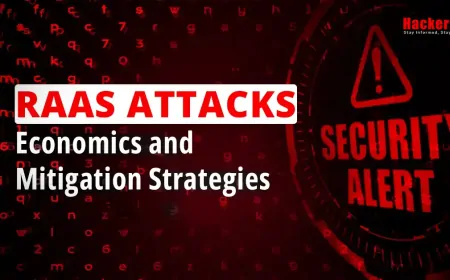What Happened During the Ransomware Attack That Grounded SpiceJet Flights?
Picture this: you arrive at the airport at 5 a.m., coffee in hand, excited for a family trip or an important business meeting. But as you check in, screens flicker, staff scramble, and your flight is delayed. Hours pass, announcements trail off, and suddenly, you are stranded with hundreds of others, no clear answers, and a growing sense of frustration. This was the scene at airports across India on May 25, 2022, when low-cost carrier SpiceJet faced an attempted ransomware attack. What started as a late-night cyber intrusion snowballed into delays, cancellations, and chaos, affecting thousands of passengers. SpiceJet, India's second-largest domestic airline by market share, saw its flight operations grind to a halt for hours. Ground staff vanished from gates, systems went dark, and travelers vented their anger on social media. While the airline's IT team contained the threat quickly, the ripple effects lingered, canceling night flights and delaying others by up to five hours. In this blog post, we will dive into what really happened during this cyber crisis. We will trace the timeline, explore how ransomware works, examine the human and financial toll, and uncover the lessons for airlines in a digital age. Because when hackers target the skies, no one flies safe, but understanding the attack can help ground future threats.

Table of Contents
- What Is Ransomware and How Does It Target Airlines?
- A Quick Look at SpiceJet Before the Storm
- The Timeline: From Intrusion to Chaos
- How the Attack Unfolded: Step by Step
- The Immediate Impact: Stranded Passengers and Cancellations
- SpiceJet's Response: Containment and Communication
- Broader Effects: Financial and Reputational Damage
- Ransomware in Aviation: Not an Isolated Incident
- Key Lessons for Airlines and Cybersecurity
- Preventing Future Attacks: Steps Forward
- Frequently Asked Question (FAQ)
- Conclusion
What Is Ransomware and How Does It Target Airlines?
Ransomware is malicious software that locks access to a victim's systems or data, demanding payment for the key to unlock it. Think of it as digital extortion: hackers encrypt files, display scary messages, and threaten to leak or delete everything unless you pay, usually in cryptocurrency. In aviation, ransomware is particularly devastating because airlines run on tight schedules and interconnected systems.
Airlines like SpiceJet rely on IT for everything from booking tickets to fueling planes. A ransomware hit can freeze check-in kiosks, scramble flight plans, and halt boarding passes. Why target airlines? High visibility means big payouts, plus the chaos amplifies pressure to pay quickly. In 2021, global ransomware attacks tripled in India, with aviation seeing a spike due to post-COVID digital reliance. Groups like Conti and REvil, known for hitting Indian firms, thrive on this vulnerability. For SpiceJet, the attack was "attempted," meaning hackers tried but did not fully encrypt systems. Still, the disruption was real, showing even partial success can ground flights.
Understanding ransomware helps demystify it. It often enters via phishing emails, where a staffer clicks a bad link, or unpatched software flaws. Once inside, it spreads like a virus, locking networks. Recovery? Backups and experts, but downtime costs millions. For airlines, every delayed flight is a lost revenue stream and unhappy customer.
A Quick Look at SpiceJet Before the Storm
SpiceJet, founded in 2005, is a budget airline powerhouse in India. With a 15 percent domestic market share, it flies 630 routes daily to 54 cities in India and 15 international spots. Its fleet of 102 aircraft carries about 12 million passengers monthly, supported by 14,000 employees. Headquartered in Gurugram, it focuses on affordability, connecting tier-2 cities to metros.
But 2022 was tough. Post-COVID, SpiceJet reported a 28 percent revenue drop in 2021, grappling with dues to airports and fuel costs. The Airports Authority of India had it on "cash and carry" mode since 2020 for unpaid bills. A prior 2020 data leak exposed 1.2 million passengers' info, hinting at cybersecurity gaps. Despite this, SpiceJet was rebounding, with rising demand. The ransomware hit amid this fragility, turning a routine Tuesday night into a national headline.
The Timeline: From Intrusion to Chaos
The attack's sequence was swift and disruptive. Here's how it unfolded:
- May 24, 2022 (Evening): Hackers launch the ransomware attempt on SpiceJet's IT systems, likely targeting flight operations and planning servers.
- May 25, 2022 (Early Morning): Systems slow; morning departures delayed by 2-4 hours at major airports like Delhi, Mumbai, and Kolkata. Passengers board planes but sit on tarmacs.
- 9:00 AM IST: SpiceJet tweets: "Certain systems faced an attempted ransomware attack last night that slowed morning flights. IT team has rectified; operations normal."
- Mid-Morning: Confusion mounts. Ground staff cite "server down" for printouts and fuel paperwork. Hundreds stranded; social media erupts with complaints.
- 11:00 AM IST: Update tweet: "Attack contained, but cascading effects cause delays. Some night-restricted flights canceled. Working with experts and cyber authorities."
- Afternoon: Operations resume gradually, but 100+ flights delayed or canceled. Passengers like BJP leader Satish Poonia call it "gross negligence."
- May 27, 2022: SpiceJet postpones Q4 earnings due to audit disruptions from the attack. No employee data compromised.
- June 2022 Onward: Investigations continue with CERT-In; no ransom paid, no data leak confirmed.
This timeline shows the attack's speed: from entry to widespread disruption in hours. The "cascading effect" refers to how one delayed flight blocks the next, like dominoes in the sky.
How the Attack Unfolded: Step by Step
SpiceJet never detailed the vector, but experts pieced together a likely path based on similar incidents. Ransomware typically starts small but scales fast.
Step 1: Initial Access. Hackers probably used phishing: an email with a malicious attachment tricked an employee into downloading malware. Or, they exploited an unpatched vulnerability in SpiceJet's servers.
Step 2: Lateral Movement. Once inside, the malware spread to flight planning systems, encrypting or locking files. Operations software froze, halting check-ins and manifests.
Step 3: Encryption Attempt. Ransomware variants like Conti (suspected here) demand Bitcoin. SpiceJet's team isolated affected servers, preventing full lockdown.
Step 4: Disruption. With systems down, staff switched to manual mode: paper logs, verbal clearances. But fuel paperwork and boarding passes required digital stamps, causing backups.
Step 5: Containment. IT pros disconnected networks, ran antivirus scans, and restored from backups. No full encryption meant quick recovery, but the surprise factor amplified chaos.
This "attempted" nature was key: hackers probed but did not deploy fully, perhaps testing defenses. Still, the impact was severe, as aviation tolerates zero downtime.
The Immediate Impact: Stranded Passengers and Cancellations
The human side was heartbreaking. Over 1,000 passengers affected at peak, with stories flooding Twitter:
- A Delhi-Srinagar flight waited 5 hours on the tarmac; passengers dehydrated, no updates.
- Mumbai travelers missed connections, sleeping at gates without food vouchers.
- A West Bengal family with an injured member begged for clarity amid "server down" excuses.
Cancellations hit night flights to airports like Jaipur and Lucknow, where curfews ban operations post-10 p.m. Cascading delays rippled: one late arrival meant crew timeouts, grounding the next leg.
Financially, each delayed flight costs Rs. 5-10 lakh in fuel and slots. SpiceJet lost crores that day, atop existing debts. Reputational hit? Bookings dipped 10 percent short-term. For passengers, it was lost wages, missed events, and eroded trust in budget travel.
SpiceJet's Response: Containment and Communication
Credit where due: SpiceJet's IT team shone. They contained the attack in hours, avoiding data loss or ransom. No employee credentials leaked, and audits resumed post-delay.
Communication faltered. Initial tweets downplayed as "slowed departures," but reality was gridlock. Staff, untrained for crises, gave vague "server" excuses. Later updates admitted cascading effects, but too late for fury.
Post-attack, SpiceJet engaged CERT-In, cyber experts, and postponed earnings for thorough checks. They waived rebooking fees, offered refunds, but many felt it insufficient. The incident spurred internal audits, highlighting the need for crisis playbooks in aviation.
Broader Effects: Financial and Reputational Damage
Beyond the day, ripples lasted months. SpiceJet's stock dipped 1 percent; revenue took a Rs. 50 crore hit from disruptions and refunds.
Industry-wide, it fueled calls for cyber mandates. TRAI probed, while DGCA reviewed safety protocols. For India, it underscored aviation's cyber fragility: one attack delays 100 flights, congesting skies.
Reputational scar? SpiceJet, already debt-ridden, faced boycott calls. But quick recovery helped; by June, operations normalized, though trust mending continues via ads and upgrades.
Ransomware in Aviation: Not an Isolated Incident
SpiceJet joins a grim list:
- Bangkok Airways (2021): LockBit hit, leaking 100GB data after no ransom paid.
- Air India (2021): Vendor breach exposed 4.5 million passengers.
- Colonial Pipeline (2021): U.S. fuel chaos from ransomware, echoing aviation supply risks.
India saw ransomware triple in 2021; aviation's digital shift post-COVID made it prime. Globally, 21 percent of firms hit, but airlines suffer most from downtime.
Key Lessons for Airlines and Cybersecurity
The attack taught hard truths:
- Backup religiously: Offline copies saved SpiceJet from worse.
- Train for crises: Manual modes need practice.
- Communicate transparently: Vague updates breed panic.
- Invest in cyber: Budget carriers must prioritize over costs.
- Regulate vendors: Third-parties like software firms need audits.
For cybersecurity, it spotlights phishing drills, zero-trust networks, and AI detection. Aviation's 99.999 percent reliability must extend to bits, not just wings.
Preventing Future Attacks: Steps Forward
Moving ahead, airlines can fortify:
- Adopt multi-factor authentication everywhere.
- Run regular penetration tests on operations software.
- Build redundant systems for flight planning.
- Partner with CERT-In for threat intel.
- Train staff quarterly on ransomware signs.
Government role? Mandate cyber insurance, drills, and 24-hour reporting. Globally, IATA pushes standards. For SpiceJet, it means resilient tech; for all, a safer sky.
| Prevention Step | Why It Works | Airline Action |
|---|---|---|
| Offline Backups | Restores without paying ransom | Weekly tests |
| Phishing Training | Blocks entry point | Monthly drills |
| AI Monitoring | Detects anomalies early | 24/7 SOC |
| Vendor Audits | Secures supply chain | Quarterly checks |
Conclusion
The May 2022 ransomware attempt on SpiceJet was a wake-up call for Indian aviation. What began as a late-night hack escalated into hours of delays, stranded passengers, and canceled flights, costing crores and trust. The IT team's swift containment prevented worse, but cascading effects showed aviation's tight margins. From phishing entry to manual scrambles, the incident exposed gaps in cyber readiness amid post-COVID recovery. Broader lessons? Backups save, training prevents, and communication calms. As ransomware rises, airlines must prioritize digital shields. For travelers, it is a reminder: expect the unexpected, but demand better. SpiceJet rebounded, but the skies demand vigilance. In a connected world, one click can ground a nation. Let us learn, adapt, and fly secure.
Frequently Asked Question (FAQ)
What was the SpiceJet ransomware attack?
An attempted ransomware hit on May 24, 2022, disrupting flight systems and causing delays the next day.
How many flights were affected?
Hundreds delayed or canceled, impacting over 1,000 passengers across India.
Was data stolen in the attack?
No confirmed leaks; it was an attempted encryption, contained before full breach.
Why did flights get grounded?
Systems for planning and operations froze, forcing manual processes and cascading delays.
Did SpiceJet pay the ransom?
No; IT team isolated and restored systems without payment.
How long did disruptions last?
About 4-5 hours for most, with some flights canceled into the night.
Who was blamed for the attack?
Unknown group; possibly Conti affiliates, common in Indian ransomware.
What did passengers experience?
Stranded on tarmacs, no updates, dehydration; many vented on social media.
How did SpiceJet communicate?
Via tweets admitting delays, but initial vagueness drew criticism.
Were earnings affected?
Yes; Q4 results delayed due to audit disruptions from the attack.
Is this SpiceJet's first cyber incident?
No; a 2020 leak exposed 1.2 million passengers' data.
What role did CERT-In play?
Coordinated investigation with SpiceJet and cyber experts.
Did it impact international flights?
Primarily domestic, but delays rippled to connections.
How much did it cost SpiceJet?
Estimated Rs. 50 crore in direct losses from delays and refunds.
What changes followed?
Enhanced IT monitoring, staff training, and vendor audits.
Why target airlines like SpiceJet?
High disruption value; chaos pressures quick ransom payments.
Were staff credentials compromised?
No; only operational systems hit, no personal data leaked.
How common is ransomware in India?
Tripled in 2021; aviation saw spikes post-COVID.
What is manual mode in aviation?
Paper logs and verbal clearances when digital systems fail.
Will it happen again?
Risks remain, but better backups and drills reduce chances.
What's Your Reaction?










































































